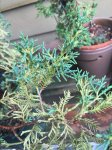CWTurner
Omono
This is the tree that was included in my first bonsai lesson in November 2014. Since the styling that fall, all I have done is repot it into a smaller pot, watered and fed it with that blue granules and fish fertilizer. Oh, and I gave it (and all my other trees) a dunk in the Bayer 12 Month Tree and Shrub Protect and Feed at slightly less than recommended strength.

Last summer (before the dunking)it began to turn this pale shade of green. I scratched the bark and it didn't look green, so I wrote it off as dead. Still I generally cared for it as if it were alive.
This spring I am getting nice greener tips, and even some little blue/green buds, but the overall tree is still quite pale (compare to the shimpaku seedling on its right).
Any ideas what I did wrong, or didn't do right?
I was thinking Ironite to get it greener, but want some opinions before I do.
CW

Last summer (before the dunking)it began to turn this pale shade of green. I scratched the bark and it didn't look green, so I wrote it off as dead. Still I generally cared for it as if it were alive.
This spring I am getting nice greener tips, and even some little blue/green buds, but the overall tree is still quite pale (compare to the shimpaku seedling on its right).
Any ideas what I did wrong, or didn't do right?
I was thinking Ironite to get it greener, but want some opinions before I do.
CW


